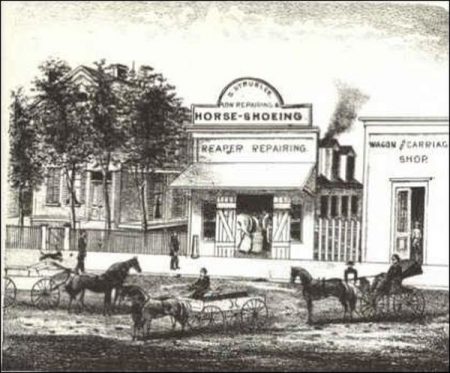The Constitution of 1848, designed for a rural State, had made no adequate provisions for this new industrialism, creating such problems as police and fire protection in congested areas, sanitation, metropolitan city governments, and a flexible judicial system. A constitutional convention had been called in the midst of the Civil War, but the proposed new constitution had been rejected by the people.
Newspapers contnued to denounce the evils under the old constitution. The right of the legislature to pass private laws, said the Illinois State Register, was “a practice which invited corruption on the part of the members of the State legislature and instilled in the minds of the people a suspicion that state laws and bribery were intimately associated, if not inseparable.”
In I870another convention, almost equally divided between the Democratic downstate and the Republican north, submitted after long sessions a constitution which was ratified. It granted the franchise to Negroes, but not to women; one delegate remarked during the debate that the adherents of women suffrage were “long haired men and short-haired women.” It also provided that the Illinois and Michigan canal was never to be leased or sold without referendum, established a system o cumulative voting, (see Government and Education) for the State representatives, created enlarged courts in Cook County and necessary legal powers to govern metropolitan Chicago, and increased the responsibility of the State for the support of educational institutions.
The new industrialism brought a raw transition period in the life of the State. Newspapers cried out against the lawlessness that prevailed. It was said that in Cairo a man a week was killed, while Chicago was a haven for gamblers, “bunko ropers,” confidence men, and murderers. Springfield, declared the Illinois State Register, was infested with “an unwholesome debris of bullies, strumpets, vagrants, and sneak-thieves.”
But by far the greatest calamity of the decade was the Chicago Fire of October 8-9, 1871 (see Chicago), as a result of which 250 people lost their lives, thousands were left homeless and destitute, and the financial loss was estimated at 200 million dollars. With the aid of other States and even foreign nations, the city was quickly rebuilt, but the terror and suffering were not soon forgotten.
Discontent was growing among the farmers. They objected strenuously to excessive charges by middlemen, exorbitant freight rates, and the high price of manufactured goods. Illinois was still a farm State, with six-sevenths of its 35 million acres under cultivation as late as 1880. The invention and manufacture of farm implements had made considerable progress (see Agriculture), and yet in 1873 the secretary of the Illinois State Farmers’ Association described the typical home of the Illinois farmer as “a bare black wretched abode, fit for nothing but the squalid and pigs.”
The farmers organized. The Order of Patrons of Husbandry, founded in 1868, was the forerunner of the Grange movement in Illinois. The original purpose of the Patrons–the purchasing of machinery for members at a discount–broadened in the early seventies when hundreds of new granges organized, with a peak of 761 in 1873 and 704 in 1874.
With the Grange movement came political pressure that forced the passage of the railroad acts of 1871, which stipulated that charges for long hauls were never to be less than for short hauls, that storage fees were to be uniform, and that no road was to charge a greater mileage rate on one section of its line than on any other. The second State railroad commission in the country was created, but the railroads refused to recognize the rates set.
Farmers boarded the trains and offered the “legal fares,” with results such as these reported in the Prairie Farmer of February 15, 1873: “The railroads of the state, in some cases, carry passengers free who will only pay the legal fare. In other cases such passengers are ejected by force. At Rantoul, the other day, a whole carload of legal fare passengers were switched off on a side track and left, while the engine and the balance of the train went on.”
In some instances hired thugs were employed by the railroads. When the railroad act was held unconstitutional by the State Supreme Court in 1873, the indignation of the farmers soon forced the passage of another act. The farmers were now a powerful political factor; to win an election, a politician had to entitle himself the “farmers’ candidate”; they carried the judicial elections of 1873, and in 1874 elected a State superintendent of public instruction.
The Chicago Tribune, an enemy of the movement, aptly summed up the issues in the Greenback fight of 1876: “The creditor East, having unloaded his sixty-cent dollar on the West, can hardly object to being paid in the same kind of currency, worth now, however, ninety-five cents on the dollar.” But Republicanism won both the 1876 and the 1880 elections after bitter campaigns, and the Greenback movement merged with the growing labor movement that developed rapidly after the great railroad strikes of 1877.
The National Labor Union had been organized in 1866 and the Knights of Labor in 1869. The Workingmen’s Party of Illinois, with a platform advocating the prevention of monopolies, abolition of child labor, compulsory education of children under 14, public ownership of the means of transportation and communication, State management of banks, and a number of wage regulations was formed. Its program was branded by the Chicago Tribune as “socialistic heresies too far from our institutions to gain a foothold among us.” Social forces were at work that broke the hold of John A. Logan and his Republican political machine in 1892, the only time the Republicans in the State were defeated from the Civil War to 1912.
In thriving young cities diversified industries were springing up-machine shops, foundries, coal mines, steel plants, and stockyards. The number of wage earners in manufacturing grew from 11,559 in 1850, to 82,979 in 1870, and 312,198 in 1890. With this industrial growth came poverty and unemployment, disease and slums; people began to talk about “trusts and combinations.” Men and women who had deserted farms and towns for factories and cities were buffeted and beaten. To their aid came the labor organizations.
Membership in the Knights of Labor grew rapidly; strikes became more numerous. Employers answered the growing protest of labor with the lock-out, the legal and political machinery, Pinkerton operatives, and strongarm men. In 1880 the Illinois State Register characterized workers locked out at the Chicago Stockyards as “traitors, not only to their wives and children, but to society and government. They are entitled to the severest penalty of the violated law, supplemented, if need be, by copious showers of shot and shell.”
The Knights of Labor met in Chicago in June 1884, and passed resolutions calling for the eight-hour day, the incorporation of labor unions, the prohibition of work by children under 14, an employers’ liability act, and a mechanic’s lien law. Sympathy with the labor program became so great that in the next two years politicians became “friends of labor,” as in the preceding decade of agrarian revolt they had been “friends of the farmer.”
The fight for the eight-hour day continued unabated; the Knights of Labor formed a hundred new lodges throughout the State each week early in 1886. Even the press began to favor the eight-hour day, saying it was theoretically sound, so long as labor asked only for eight hours’ pay, but warned against allowing the movement to “degenerate to a demand for the 8-hour day with 10-hour pay.” The fight would probably have been successful but for the unfortunate Haymarket bomb of May 4, 1886, and the subsequent hysteria. Every manifestation of sympathy with labor thereafter branded one as an anarchist, and strike after strike collapsed in June and July.
Despite the reaction, general restlessness continued. Farmers, harassed by the discriminatory protective tariff and the vexing currency problems, joined with the Illinois State Labor Association at Decatur in April 1888 to form the Illinois Labor Party, which disintegrated rapidly through lack of harmony. The Democratic nominee for governor, John M. Palmer, took a stand for labor, denouncing the Pinkerton corps of private detectives who, he said, had been hired by the industrialists to break the strikes of the preceding year. He was repudiated by the conservative voters and members of his own party.
But the road was paved for the farmer-labor-Democratic coalition, which in 1892 elected judge John P. Altgeld to the governorship. Altgeld personified the whole spirit of the revolt of the farmers and workers in the seventies and eighties. His enemies called him an anarchist, but the Illinois State Register, in answering the attack on Altgeld by the Journal in 1892, asked why it was strange “for a candidate for governor to notice the workingman, much less shake his soiled hands; it tries to cast ridicule on judge Altgeld for visiting railroad shops and mines to meet and become acquainted with intelligent and worthy toilers . . . it is not the custom of the fine haired Republican office-holders to do so.”
After the election Altgeld cleaned house. He appointed Florence Kelley, who had been associated with Jane Addams at Hull House, as factory inspector; he inaugurated the indeterminate sentence and the parole system, built hospitals for the insane at Bartonville and Peoria, improved the State school system, gave liberal grants to the University of Illinois, pardoned the three anarchists who had survived the Haymarket trial in a message that condemned the proceedings as unfair and illegal, and objected to the sending of Federal troops into the State by President Cleveland during the 1894 Pullman strike. Although he was not re-elected, and his acts brought him financial as well as political ruin, he had won for himself a lasting place in the history of the State; he is remembered as an uncompromising lover of justice and humanity, and as one of its greatest Governors. In Altgeld the hopes of farmers and workers were resurrected temporarily after two decades of crushing defeat.
In a far different sphere the World’s Columbian Exposition of 1893, “the World’s Fair,” gave Illinois a chance to exhibit its development. Of it Henry B. Fuller wrote, “for the first time cosmopolitanism visited the western world, for the first time woman publicly came into her own, for the first time on a grand scale, art was made vitally manifest to the American consciousness.” Congresses on social reform, women’s progress, science and philosophy, literature, education, and commerce, were held. Said Theodore Dreiser:
All at once and out of nothing, in this dingy city of six or seven hundred thousand which but a few years before had been a wilderness of wet grass and mud flats, and by this lake which but a hundred years bef ore was a lone silent waste, had now been reared this vast and harmonious collection of perfectly constructed and showy buildings, containing in their delightful interiors, the artistic, mechanical and scientific achievements of the world.
While the Exposition was making cultural history, the University of Chicago was progressing through the efforts of President William Rainey Harper, formerly professor of Hebrew at Yale, aided by the gifts of John D. Rockefeller. With “metropolitan” dailies in Springfield, Peoria, Bloomington, Cairo, and Chicago; with baseball teams that toured the world; with an Art Institute housed in a “Palladian Palace” built in 1892; with the University of Chicago, the State university at Urbana, Northwestern University in Evanston, and many normal schools and colleges; Illinois by 1893 had accepted the culture and had become an opulent symbol of industrialism.
Visits: 120



